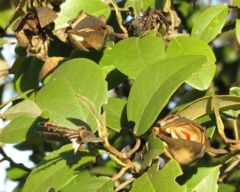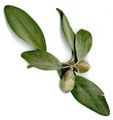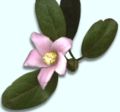Lagunaria: Difference between revisions
No edit summary |
No edit summary |
||
| Line 1: | Line 1: | ||
{{Inc| | |||
Lagunaria (named for its resemblance to Lagunaea, which is now considered a section of Hibiscus | |||
and commemorates a Spanish botanist, Andres de Laguna,1494 or 1499-1560, physician to Pope | |||
Julius III). Malvaceae. An Australian (or Norfolk Island) tree cult. outdoors in S. Calif. and | |||
indoors in Eu. It has large pale rose fls. like Hibiscus, 2 1/2 in. across, with 5 spreading lobes, a column of stamens and a 5-lobed shield-shaped stigma. It differs from Hibiscus in having only 3, 4 | |||
or 5 deciduous bracelets, while Hibiscus usually has 5 or more. Lvs. entire: fls. axillary; calyx | |||
5-toothed; ovary 5- celled.—Species probably only 1. | |||
}} | |||
{{Taxobox | {{Taxobox | ||
| color = lightgreen | | color = lightgreen | ||
Revision as of 22:45, 12 May 2009
| Standard Cyclopedia of Horticulture |
|---|
|
Lagunaria (named for its resemblance to Lagunaea, which is now considered a section of Hibiscus and commemorates a Spanish botanist, Andres de Laguna,1494 or 1499-1560, physician to Pope Julius III). Malvaceae. An Australian (or Norfolk Island) tree cult. outdoors in S. Calif. and indoors in Eu. It has large pale rose fls. like Hibiscus, 2 1/2 in. across, with 5 spreading lobes, a column of stamens and a 5-lobed shield-shaped stigma. It differs from Hibiscus in having only 3, 4 or 5 deciduous bracelets, while Hibiscus usually has 5 or more. Lvs. entire: fls. axillary; calyx 5-toothed; ovary 5- celled.—Species probably only 1.
|
| Lagunaria patersonia {{{status}}} Fossil range: {{{fossil_range}}}
| ||||||||||||||||||||||||||||||||||||||||||||||||||||||||||||||||||
|---|---|---|---|---|---|---|---|---|---|---|---|---|---|---|---|---|---|---|---|---|---|---|---|---|---|---|---|---|---|---|---|---|---|---|---|---|---|---|---|---|---|---|---|---|---|---|---|---|---|---|---|---|---|---|---|---|---|---|---|---|---|---|---|---|---|---|
 Leaves and fruit | ||||||||||||||||||||||||||||||||||||||||||||||||||||||||||||||||||
| Plant Info | ||||||||||||||||||||||||||||||||||||||||||||||||||||||||||||||||||
| ||||||||||||||||||||||||||||||||||||||||||||||||||||||||||||||||||
| Scientific classification | ||||||||||||||||||||||||||||||||||||||||||||||||||||||||||||||||||
| ||||||||||||||||||||||||||||||||||||||||||||||||||||||||||||||||||
| [[{{{diversity_link}}}|Diversity]] | ||||||||||||||||||||||||||||||||||||||||||||||||||||||||||||||||||
| {{{diversity}}} | ||||||||||||||||||||||||||||||||||||||||||||||||||||||||||||||||||
| Binomial name | ||||||||||||||||||||||||||||||||||||||||||||||||||||||||||||||||||
| Lagunaria patersonia (Andrews) G.Don. | ||||||||||||||||||||||||||||||||||||||||||||||||||||||||||||||||||
| Trinomial name | ||||||||||||||||||||||||||||||||||||||||||||||||||||||||||||||||||
| {{{trinomial}}} | ||||||||||||||||||||||||||||||||||||||||||||||||||||||||||||||||||
| Type Species | ||||||||||||||||||||||||||||||||||||||||||||||||||||||||||||||||||
| {{{type_species}}} | ||||||||||||||||||||||||||||||||||||||||||||||||||||||||||||||||||
| {{{subdivision_ranks}}} | ||||||||||||||||||||||||||||||||||||||||||||||||||||||||||||||||||
| [[Image:{{{range_map}}}|{{{range_map_width}}}|]] | ||||||||||||||||||||||||||||||||||||||||||||||||||||||||||||||||||
| Synonyms | ||||||||||||||||||||||||||||||||||||||||||||||||||||||||||||||||||
| {{{synonyms}}} |
Lagunaria is a monotypic genus in the family Malvaceae. It is an Australian plant endemic to Lord Howe Island, Norfolk Island and parts of coastal Queensland. It has been introduced to many parts of the world. The genus was named in honour of Andrés Laguna, a Spanish botanist and a physician to Pope Julius III.
It now consists of the single species Lagunaria patersonia, commonly known as the Pyramid Tree or Norfolk Island Hibiscus. It is howevever not a true Hibiscus, but does belong to the same plant family, Malvaceae. Its seed capsules are filled with irritating hairs giving rise to an another common name "Cow Itch Tree". The "cow" part however appears to be a misnomer.
References
Gallery
-
Fruit of the Pyramid Tree
-
Flower of the Pyramid Tree

